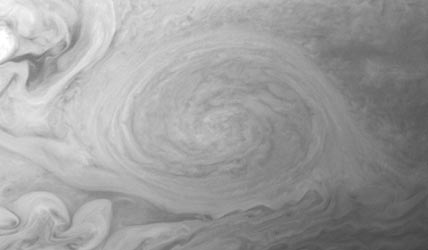
Jupiter's "Little Red Spot," also known as spot BA, was captured by the New Horizons spacecraft on February 27, 2007. This Earth-size storm spins counterclockwise. Click on the image for a larger view.
Kelly Beatty
Recently planetary specialists have been struggling to get good views of a giant new storm system on Jupiter, dubbed "Little Red Spot" or "Red Spot Jr." but known officially as spot BA. So the New Horizons team obliged by having the spacecraft snap this stunningly detailed view of the spot as it approached the giant planet on February 27th. At the time New Horizons was some 3 million kilometers (1.9 million miles) from Jupiter, but the craft's Long-Range Reconnaissance Imager managed to capture details as small as about 30 km (20 miles).
The Little Red Spot is an Earth-sized storm that represents the merger of three smaller white ovals, first seen in 1939, designated FA, BC, and DE. Two of them merged in 1998, and the third joined them in 2000 — and then the giant oval started turning red in 2005. Its clouds rotate counterclockwise, meaning that it is an anticyclonic, high-pressure system. Hurricanes and typhoons on Earth, which are low-pressure systems, spin the opposite way. A smaller, brighter oval to the south of BA is another storm moving rapidly to the right (east); click on the image above to see it in an enlarged view.
New Horizons passed 2.3 million km (1.4 million miles) from Jupiter on February 28th, a flyby that accelerated the craft to a speed of 84,000 km (52,000 miles) per hour and hurled it toward a rendezvous with Pluto in July 2015. New Horizons has already recorded about 35 gigabytes of observations during its swing through the Jovian system, and about 20% of those data have been radioed to Earth.
For more information, visit the mission's website.
 0
0
Comments
You must be logged in to post a comment.